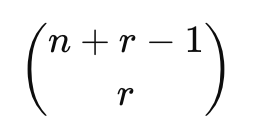discrete math
1/71
There's no tags or description
Looks like no tags are added yet.
Name | Mastery | Learn | Test | Matching | Spaced |
|---|
No study sessions yet.
72 Terms
proposition
a sentence that can only be true or false
¬p
NOT p
p ∧ q
p AND q
p ∨ q
p OR q
p → q
IF p THEN q
p ↔ q
q IF AND ONLY IF p
p ⊕ q
XOR (p or q but not both)
∀x
all x
∃x
at least one x
double negative
¬(¬p) ≡ p
De Morgan’s Laws
NOT acts as distributor for AND and OR
biconditional
p ↔ q ≡ (p → q) ∧ (q → p)
implication flip
p → q ≡ ¬p ∨ q
(if you drink milk, you get sick = either don’t drink milk or you get sick)
sufficient
condition, then q
necessary
q, then condition
converse
if q then p
inverse
if not p then not q
contrapositive
if not q then not p
predicate
sentence with a blank
modus ponens
p → q and p is True, then q is True
modus tollens
p → q, and q is False (¬q), then p is False (¬p)
hypothetical syllogism
p → q and q → r, then p → r
disjunction syllogism
p ∨ q and p is False (¬p), then q is True (q)
addition
if p is True, then p ∨ q is True
simplification
if p ∧ q is True, then p is True and q is True
conjunction
if p = T and q = T, then p∧ q is True
resolution
if p ∨ q and ¬p ∨ r, then q ∨ r
direct proof
given → follow logic → reach the conclusion
contrapositive proof
Prove ¬Q → ¬P instead of P → Q
proof by contradiction
Assume the opposite of what you want to prove → reach a contradiction
vacuous proof
If the premise is false, the implication is automatically true. (ex: “If I’m a potato then I’m a millionaire.”)
trivial proof
If the conclusion is always true, the implication is automatically true. (ex: “If I have five heads, then 1 = 1.”)
Universal Instantiation
Take a general truth and apply it to all.
Universal Generalization
All proofs of something True creates a generalization.
Existential Instantiation
If at least one of something exists, confirm its existence by naming it uniquely.
Existential Generalization
If there’s at least one example of something existing, then one or some exist.
x ∈ A
x is an element of A
x ∉ A
x is not in A
union
A ∪ B (OR)
difference
A − B (elements in A but not B)
intersection
A ∩ B (AND)
complement
A̅ (everything in not A)
cartesian
A × B (pairs of elements)
cardinality
the number of elements in a set (|A|)
bitstring
a string of 1’s and 0’s that are used to represent T and F in a set if numbers (1=T and 0=F)
injective / one-to-one
every input has a different output, no two inputs share the same out put (ex: f(x) = x2 doesn’t work because f(-2)=f(2))
surjective / onto
every codomain has to have an x, every f(x) has an x
bijective
a function that is both and injective and surjective
floor function ⌊x⌋
rounds down to the nearest whole number
ceiling function ⌈x⌉
rounds up to the nearest whole number
well-ordering principle
every non-empty set of positive integers has a smallest element
strong induction
a regular induction but for multiple values
mathematical induction
a method to prove a statement is true for all positive integers
1 root closed form
an = (C1 + C2)(rn)
2 roots closed form
an = C1r1n + C2r2n
recursion
when a value depends on previous values
iteration
plugging in values until you see a pattern
combination

permutation

pigeonhole principle
[ N/k ]
binomial theorem

generalized permutations
when you have repeating elements in a set

combinations with repetition
when choosing items with replacement and order doesn’t matter

PIE
principles of inclusion and exclusion
PIE for 2 sets
∣A∪B∣=∣A∣+∣B∣−∣A∩B∣
PIE for 3 sets
∣A∪B∪C∣=∣A∣+∣B∣+∣C∣−∣A∩B∣−∣A∩C∣−∣B∩C∣+∣A∩B∩C∣
Baye’s theorem
P(A|B) = (P(B|A) * P(A)) / P(B)
Bernalli’s Theorem
P(k successes) = C(n, k)pk(1-p)n-k
independent events
P(A∩B) = P(A) * P(B)
P (A∪B) disjoint
P(A) + P(B)
P (A∪B) overlap
P(A) + P(B) - P(A∩B)
conditional probability
P(A∩B) / P(B)